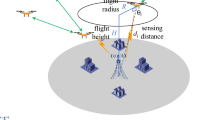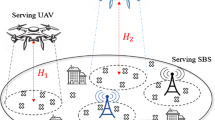Abstract
Cognitive Radio (CR) Network is a backbone for the 5G cellular Networks and Unmanned Aerial Vehicle (UAV) user identification at low power levels is a biggest task CR. Detection of UAV user is more difficult than the stable or fixed user. In the available literature various authors proposed their research with single detection algorithms low power levels as well as concatenation of two or three detection methods. To estimate the user presence the existing detection methods proposed with covariance based approach at static or predefined threshold power levels. In this paper, the authors proposed a novel Aninath computation detection algorithm to estimate the threshold dynamically with inverse covariance approach to improve the Probability of Detection (PD) and mitigate the Probability of false alarm (Pfa) and Probability of miss detection (Pmd) at low power levels.









Similar content being viewed by others
References
Badrinath, S., & Reddy, V. U. (2009). A hybrid energy detection approach to spectrum sensing. In 2009 first UK-India international workshop on cognitive wireless systems (UKIWCWS), December (pp. 1–6). IEEE.
Moghimi, F., Schober, R., & Mallik, R. K. (2011). Hybrid coherent/energy detection for cognitive radio networks. IEEE Transactions on Wireless Communications, 10(5), 1594–1605
Nadler, B., Penna, F., & Garello, R. (2011). Performance of eigenvalue-based signal detectors with known and unknown noise level. In 2011 IEEE international conference on communications (ICC), June (pp. 1–5). IEEE.
Shirazi, S. F., Shirazi, S. H., Shah, S. M., & Shahid, M. K. (2012). Hybrid spectrum sensing algorithm for cognitive radio network. International Journal of Computer Applications, 45(17), 25–30
Geethu, S., & Narayanan, G. L. (2012). A novel selection based hybrid spectrum sensing technique for cognitive radios. In 2012 2nd international conference on power, control and embedded systems, December (pp. 1–6). IEEE.
Jasbi, F., & So, D. K. (2014). Hybrid overload MC-CDMA for cognitive radio networks. In 2014 IEEE international conference on communications (ICC), June (pp. 1460–1465). IEEE.
Gmira, S., Kobbane, A., & Sabir, E. (2015). A new optimal hybrid spectrum access in cognitive radio: Overlay-underlay mode. In 2015 international conference on wireless networks and mobile communications (WINCOM), October (pp. 1–7). IEEE.
Budati, A. K., & Valiveti, H. (2019). Identify the user presence by GLRT and NP detection criteria in cognitive radio spectrum sensing. International Journal of Communication Systems, 2019, e4142
Budati, A. K., Valiveti, H. & Swetha, N. (2020). User detection using cyclostationary feature detection in cognitive radio networks with various detection criteria’s. Accepted for publication in Springer AISC Proceedings.
Maeda, K., Benjebbour, A., Asai, T., Furuno, T., & Ohya, T. (2007). Recognition among OFDM-based systems utilizing cyclostationarity-inducing transmission. In 2nd IEEE international symposium on new frontiers in dynamic spectrum access networks, 2007. DySPAN 2007, April (pp. 516–523). IEEE.
Joshi, D., Sharma, N., & Singh, J. (2015). Spectrum sensing for cognitive radio using hybrid matched filter single cycle cyclostationary feature detector. International Journal of Information Engineering and Electronic Business, 7(5), 13
Sheeraz, A. A. (2014). A log-probability based cooperative spectrum sensing scheme for cognitive radio networks. Journal of Ubiquitous Systems and Pervasive Networks Procedia Computer Science, 3, 196–202
Tertinek, S. (2004). Optimum detection of deterministic and random signals.
Proakis, J. G. (1998). Digital communications fourth edition, 2001.
Papoulis, A., & Pillai, S. U. (2002). Probability, random variables, and stochastic processes. Tata McGraw-Hill Education.
Luo, J., Wang, J., Li, Q., & Li, S. (2012). GLRT based cooperative spectrum sensing with soft combination in heterogeneous networks. In 2012 IEEE international symposium on dynamic spectrum access networks (DYSPAN), October (pp. 389–396). IEEE.
Author information
Authors and Affiliations
Corresponding author
Additional information
Publisher's Note
Springer Nature remains neutral with regard to jurisdictional claims in published maps and institutional affiliations.
Rights and permissions
About this article
Cite this article
Budati, A.K., Ghinea, G. & Ganesh, S.N.V. Novel Aninath Computation Detection Algorithm to Identify the UAV Users in 5G Networks. Wireless Pers Commun 127, 963–978 (2022). https://doi.org/10.1007/s11277-021-08459-3
Accepted:
Published:
Issue Date:
DOI: https://doi.org/10.1007/s11277-021-08459-3




